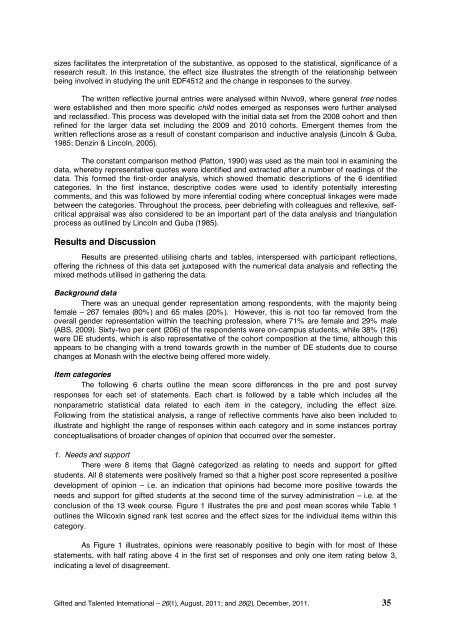The Journal of the World Council for Gifted and Talented Children
The Journal of the World Council for Gifted and Talented Children
The Journal of the World Council for Gifted and Talented Children
Create successful ePaper yourself
Turn your PDF publications into a flip-book with our unique Google optimized e-Paper software.
sizes facilitates <strong>the</strong> interpretation <strong>of</strong> <strong>the</strong> substantive, as opposed to <strong>the</strong> statistical, significance <strong>of</strong> a<br />
research result. In this instance, <strong>the</strong> effect size illustrates <strong>the</strong> strength <strong>of</strong> <strong>the</strong> relationship between<br />
being involved in studying <strong>the</strong> unit EDF4512 <strong>and</strong> <strong>the</strong> change in responses to <strong>the</strong> survey.<br />
<strong>The</strong> written reflective journal entries were analysed within Nvivo9, where general tree nodes<br />
were established <strong>and</strong> <strong>the</strong>n more specific child nodes emerged as responses were fur<strong>the</strong>r analysed<br />
<strong>and</strong> reclassified. This process was developed with <strong>the</strong> initial data set from <strong>the</strong> 2008 cohort <strong>and</strong> <strong>the</strong>n<br />
refined <strong>for</strong> <strong>the</strong> larger data set including <strong>the</strong> 2009 <strong>and</strong> 2010 cohorts. Emergent <strong>the</strong>mes from <strong>the</strong><br />
written reflections arose as a result <strong>of</strong> constant comparison <strong>and</strong> inductive analysis (Lincoln & Guba,<br />
1985; Denzin & Lincoln, 2005).<br />
<strong>The</strong> constant comparison method (Patton, 1990) was used as <strong>the</strong> main tool in examining <strong>the</strong><br />
data, whereby representative quotes were identified <strong>and</strong> extracted after a number <strong>of</strong> readings <strong>of</strong> <strong>the</strong><br />
data. This <strong>for</strong>med <strong>the</strong> first-order analysis, which showed <strong>the</strong>matic descriptions <strong>of</strong> <strong>the</strong> 6 identified<br />
categories. In <strong>the</strong> first instance, descriptive codes were used to identify potentially interesting<br />
comments, <strong>and</strong> this was followed by more inferential coding where conceptual linkages were made<br />
between <strong>the</strong> categories. Throughout <strong>the</strong> process, peer debriefing with colleagues <strong>and</strong> reflexive, selfcritical<br />
appraisal was also considered to be an important part <strong>of</strong> <strong>the</strong> data analysis <strong>and</strong> triangulation<br />
process as outlined by Lincoln <strong>and</strong> Guba (1985).<br />
Results <strong>and</strong> Discussion<br />
Results are presented utilising charts <strong>and</strong> tables, interspersed with participant reflections,<br />
<strong>of</strong>fering <strong>the</strong> richness <strong>of</strong> this data set juxtaposed with <strong>the</strong> numerical data analysis <strong>and</strong> reflecting <strong>the</strong><br />
mixed methods utilised in ga<strong>the</strong>ring <strong>the</strong> data.<br />
Background data<br />
<strong>The</strong>re was an unequal gender representation among respondents, with <strong>the</strong> majority being<br />
female – 267 females (80%) <strong>and</strong> 65 males (20%). However, this is not too far removed from <strong>the</strong><br />
overall gender representation within <strong>the</strong> teaching pr<strong>of</strong>ession, where 71% are female <strong>and</strong> 29% male<br />
(ABS, 2009). Sixty-two per cent (206) <strong>of</strong> <strong>the</strong> respondents were on-campus students, while 38% (126)<br />
were DE students, which is also representative <strong>of</strong> <strong>the</strong> cohort composition at <strong>the</strong> time, although this<br />
appears to be changing with a trend towards growth in <strong>the</strong> number <strong>of</strong> DE students due to course<br />
changes at Monash with <strong>the</strong> elective being <strong>of</strong>fered more widely.<br />
Item categories<br />
<strong>The</strong> following 6 charts outline <strong>the</strong> mean score differences in <strong>the</strong> pre <strong>and</strong> post survey<br />
responses <strong>for</strong> each set <strong>of</strong> statements. Each chart is followed by a table which includes all <strong>the</strong><br />
nonparametric statistical data related to each item in <strong>the</strong> category, including <strong>the</strong> effect size.<br />
Following from <strong>the</strong> statistical analysis, a range <strong>of</strong> reflective comments have also been included to<br />
illustrate <strong>and</strong> highlight <strong>the</strong> range <strong>of</strong> responses within each category <strong>and</strong> in some instances portray<br />
conceptualisations <strong>of</strong> broader changes <strong>of</strong> opinion that occurred over <strong>the</strong> semester.<br />
1. Needs <strong>and</strong> support<br />
<strong>The</strong>re were 8 items that Gagné categorized as relating to needs <strong>and</strong> support <strong>for</strong> gifted<br />
students. All 8 statements were positively framed so that a higher post score represented a positive<br />
development <strong>of</strong> opinion – i.e. an indication that opinions had become more positive towards <strong>the</strong><br />
needs <strong>and</strong> support <strong>for</strong> gifted students at <strong>the</strong> second time <strong>of</strong> <strong>the</strong> survey administration – i.e. at <strong>the</strong><br />
conclusion <strong>of</strong> <strong>the</strong> 13 week course. Figure 1 illustrates <strong>the</strong> pre <strong>and</strong> post mean scores while Table 1<br />
outlines <strong>the</strong> Wilcoxin signed rank test scores <strong>and</strong> <strong>the</strong> effect sizes <strong>for</strong> <strong>the</strong> individual items within this<br />
category.<br />
As Figure 1 illustrates, opinions were reasonably positive to begin with <strong>for</strong> most <strong>of</strong> <strong>the</strong>se<br />
statements, with half rating above 4 in <strong>the</strong> first set <strong>of</strong> responses <strong>and</strong> only one item rating below 3,<br />
indicating a level <strong>of</strong> disagreement.<br />
<strong>Gifted</strong> <strong>and</strong> <strong>Talented</strong> International – 26(1), August, 2011; <strong>and</strong> 26(2), December, 2011. 35


